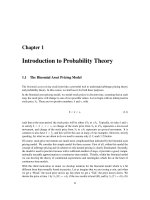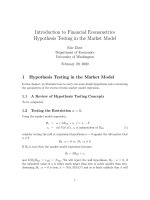Introduction to hematology
Bạn đang xem bản rút gọn của tài liệu. Xem và tải ngay bản đầy đủ của tài liệu tại đây (2.29 MB, 33 trang )
HEMATOLOGY/
HEMATOPOIESIS
Introduction
HEMATOLOGY
Introduction
•
Study of blood & its components
•
Window of rest of body
BLOOD
Raison d’etre
•
Delivery of nutrients
–
Oxygen
–
Food
–
Vitamins
•
Removal of wastes
–
Carbon dioxide
–
Nitrogenous wastes
–
Cellular toxins
•
Repair of its conduit
•
Protection versus invading microorganisms
•
Multiple cellular & acellular elements
HEMATOLOGY
Divisions
•
Red Blood Cells/Oxygen & CO
2
transport
•
White Blood Cells/Protection versus
microorganisms
•
Coagulation/platelets/Maintenance of
vascular integrity
HEMATOLOGY
Hematopoiesis
•
In humans, occurs in bone marrow
exclusively
•
All cellular elements derived from
pluripotent stem cell (PPSC)
•
PPSC retains ability to both replicate
itself and differentiate
•
Types of differentiation determined by
the influence of various cytokines
HEMATOPOIESIS
Committed Stem
Cells
RED BLOOD CELLS
Introduction
•
Normal - Anucleate, highly flexible
biconcave discs, 80-100 femtoliters in
volume
•
Flexibility essential for passage through
capillaries
•
Major roles - Carriers of oxygen to &
carbon dioxide away from cells
•
Cytokine - Produced in the kidney
•
Necessary for erythroid proliferation and
differentiation
•
Absence results in apoptosis
(programmed cell death) of erythroid
committed cells
•
Anemia of renal failure 2° to lack of
EPO
ERYTHROPOIETIN
Mechanism of Action
ERYTHROPOIETIN
Mechanism of Action
•
Binds specifically to Erythropoietin
Receptor
•
Transmembrane protein; cytokine
receptor superfamily
•
Binding leads to dimerization of receptor
•
Dimerization activates tyrosine kinase
activity
ERYTHROPOIETIN
Mechanism of Action
•
Multiple cytoplasmic & nuclear proteins
phosphorylated
•
Nuclear signal sent to activate
production of proteins leading to
proliferation and differentiation
ERYTHROPOIETIN
Regulation of Production
Response to Administration
0
10
20
30
40
50
Time
Hematocrit
rhuEPO 150 u/kg 3x/wk
RBC Precursors
•
Pronormoblast
•
Basophilic normoblast
•
Polychromatophilic Normoblast
•
Orthrochromatophilic Normoblast
•
Reticulocyte
•
Mature Red Blood Cell
•
5-7 days from Pronormoblast to
Reticulocyte
•
Number - Generally done by automated counters,
using impedance measures
•
Size - Large, normal size, or small; all same size
versus variable sizes (anisocytosis). Mean
volume by automated counter
•
Shape - Normal biconcave disc, versus
spherocytes, versus oddly shaped cells
(poikilocytosis)
•
Color - Generally an artifact of size of cell
Normal Values
RBC Parameters Normal Values
Hematocrit
Females 35-47%
Males 40-52%
Hemoglobin
Females 12.0-16.0 gm/dl
Males 13.5-17.5 gm/dl
MCV 80-100 fl
Reticulocyte Count 0.2-2.0%
RETICULOCYTE
•
Young red blood cell; still have small amounts
of RNA present in them
•
Tend to stain somewhat bluer than mature
RBC’s on Wright stain (polychromatophilic)
•
Slightly larger than mature RBC
•
Undergo removal of RNA on passing through
spleen, in 1st day of life
•
Can be detected using supravital stain
•
Important marker of RBC production
![[CEH V3] Introduction to Ethical Hacking](https://media.store123doc.com/images/document/13/ly/ap/medium_3ABUW8WdDH.jpg)








